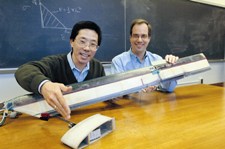Redefining "Battery Operated"
A bird in flight makes small adjustments to its wings as it soars, hovers, or dives. If airplanes and helicopters could do the same to their wings and rotors, they’d fly more efficiently and need less fuel. Now, using batteries, MIT researchers have designed a model helicopter rotor that’s able to morph.

Their work takes advantage of the mechanism that causes laptop batteries to degrade: the expansion and contraction of materials in battery electrodes. “This is a classical case of taking lemons and making lemonade,” says Yet-Ming Chiang, a materials science and engineering professor who is leading the project with aeronautics and astronautics professor Steven Hall. Articles describing their team’s work appeared in Advanced Functional Materials in March and Electrochemical and Solid State Letters in January.
[Click here for images of the professors’ “shape-shifting” rotor design.]
When a battery charges, the movement of ions from one electrode to the other causes the material of the receiving electrode to expand; as the battery discharges, the material contracts. Stress from this process can cause the internal structure of the battery to break apart over time.
For years, battery researchers have been searching for materials that expand and contract less. As part of that effort, Chiang calculated how much mechanical energy the expansion and contraction process generated, and he had an epiphany. The movement of ions during charging and discharging, he realized, was analogous to the movement of fluids between plant cells that enables plants to bend toward light. Perhaps the mechanical energy generated by batteries could be used to actuate—that is, to move—large structures.
To find out, Chiang and Hall built a morphing model that’s a short cross section of a helicopter rotor blade with a series of rectangular lithium-ion batteries inside. When, at the flip of a switch, the batteries are discharged or charged, they move a few millimeters and exert force on a strut that deforms the rotor’s shape. Chiang says such shape shifting will allow engineers to avoid a compromise that has always plagued helicopter design. Helicopters are built to do two very different things: hover and cruise. As a result, they do neither particularly well. Helicopters with shape-shifting rotors would switch between a configuration optimized for hovering and one optimized for forward motion. Chiang and Hall calculate that a military helicopter with shape-shifting rotors might be able to carry two additional people or work more efficiently during high-altitude operations over mountains.
Much of the previous research on shape morphing has focused on piezoelectric materials, whose crystal structures contain charged particles that shift in response to electricity, changing the materials’ shape. But those changes occur on an almost microscopic level, and Chiang says he long ago concluded that piezoelectrics would not work for such rigorous applications as morphing helicopter rotors. Indeed, experiments have shown that batteries produce enough mechanical energy to move a load 10 times as far as piezoelectrics.
But while piezoelectrics can change shape in a fraction of a second, says Chiang, a battery can expand only as fast as it can recharge. “Current actuation times are about one minute for a single actuation stroke,” he says. This would mean, for example, that after a helicopter switched from hovering to forward motion, it would take about a minute for its rotors to switch configuration. “But we think we can get that time down to 20 to 30 seconds with further work,” says Chiang.
Rotors might be just the beginning. Chiang and Hall point to applications on airplanes, where changing wing shapes in flight could bring similar improvements in performance and efficiency. The mechanical energy of electrodes might also be useful for actively rotating solar cells to track the sun or for unfolding large solar arrays in space. In the end, the mechanism that made batteries fall apart could make them more useful than ever.
Keep Reading
Most Popular
Large language models can do jaw-dropping things. But nobody knows exactly why.
And that's a problem. Figuring it out is one of the biggest scientific puzzles of our time and a crucial step towards controlling more powerful future models.
The problem with plug-in hybrids? Their drivers.
Plug-in hybrids are often sold as a transition to EVs, but new data from Europe shows we’re still underestimating the emissions they produce.
How scientists traced a mysterious covid case back to six toilets
When wastewater surveillance turns into a hunt for a single infected individual, the ethics get tricky.
Google DeepMind’s new generative model makes Super Mario–like games from scratch
Genie learns how to control games by watching hours and hours of video. It could help train next-gen robots too.
Stay connected
Get the latest updates from
MIT Technology Review
Discover special offers, top stories, upcoming events, and more.